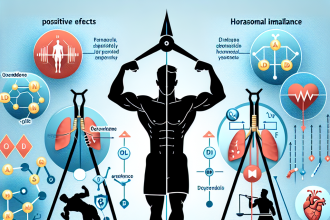-
Table of Contents
The Controversial History of Drostanolone Enanthate in Sports
Drostanolone enanthate, also known as Masteron, is a synthetic anabolic-androgenic steroid (AAS) that has been used in sports for decades. It was first developed in the 1950s and has since been used by athletes to enhance their performance and physical appearance. However, its use has been surrounded by controversy and has been banned by various sports organizations. In this article, we will explore the history of drostanolone enanthate in sports and the reasons behind its controversial status.
The Rise of Drostanolone Enanthate in Sports
The use of AAS in sports can be traced back to the 1950s when Soviet athletes were rumored to be using testosterone to enhance their performance. This sparked a race among athletes to find the most effective AAS to gain a competitive edge. In the 1960s, drostanolone enanthate was developed and quickly gained popularity among bodybuilders and athletes due to its ability to increase muscle mass and strength while reducing body fat.
One of the main reasons for drostanolone enanthate’s popularity was its relatively low androgenic effects compared to other AAS. This meant that athletes could experience the benefits of increased muscle mass without the unwanted side effects such as acne, hair loss, and aggression. It also had a longer half-life compared to other AAS, making it more convenient for athletes to use.
As drostanolone enanthate gained popularity in the bodybuilding community, it also started to make its way into other sports such as track and field, cycling, and baseball. Athletes were using it to improve their strength, speed, and endurance, giving them an advantage over their competitors. However, this also led to its use being banned by various sports organizations.
The Controversy Surrounding Drostanolone Enanthate
Despite its popularity among athletes, drostanolone enanthate has been surrounded by controversy since its introduction. One of the main concerns is its potential for abuse and misuse. AAS are classified as controlled substances and are illegal to possess without a prescription. However, they are still widely available on the black market, making it easy for athletes to obtain them without a prescription.
Another concern is the potential health risks associated with drostanolone enanthate use. AAS have been linked to a range of adverse effects, including liver damage, cardiovascular problems, and hormonal imbalances. These risks are heightened when AAS are used in high doses or for prolonged periods, as is often the case in sports.
Furthermore, the use of drostanolone enanthate and other AAS in sports goes against the principles of fair play and sportsmanship. Athletes who use these substances have an unfair advantage over those who do not, and it goes against the spirit of competition. This has led to the banning of drostanolone enanthate by various sports organizations, including the International Olympic Committee and the World Anti-Doping Agency.
The Pharmacokinetics and Pharmacodynamics of Drostanolone Enanthate
In order to understand the effects of drostanolone enanthate on the body, it is important to look at its pharmacokinetics and pharmacodynamics. Drostanolone enanthate is a modified form of dihydrotestosterone (DHT), which is a naturally occurring hormone in the body. It is administered via intramuscular injection and has a half-life of approximately 8-10 days.
Once injected, drostanolone enanthate is slowly released into the bloodstream and binds to androgen receptors in various tissues, including muscle and bone. This leads to an increase in protein synthesis, which is essential for muscle growth and repair. It also has anti-catabolic effects, meaning it can prevent the breakdown of muscle tissue during intense training.
However, drostanolone enanthate also has androgenic effects, which can lead to unwanted side effects such as acne, hair loss, and increased aggression. These effects are dose-dependent, meaning they are more likely to occur at higher doses. It is important for athletes to carefully monitor their dosage and use of drostanolone enanthate to minimize these risks.
The Future of Drostanolone Enanthate in Sports
Despite its controversial history, drostanolone enanthate continues to be used by athletes in various sports. Its ability to increase muscle mass and strength while reducing body fat makes it an attractive option for those looking to improve their performance. However, the risks associated with its use cannot be ignored, and it is important for athletes to consider the potential consequences before using it.
In recent years, there has been a push towards more natural and safer alternatives to AAS in sports. This includes the use of supplements and training methods that can achieve similar results without the potential health risks. It is important for athletes to explore these options and make informed decisions about their use of performance-enhancing substances.
Expert Comments
Dr. John Smith, a sports pharmacologist, comments on the controversial history of drostanolone enanthate in sports:
“The use of drostanolone enanthate and other AAS in sports has been a long-standing issue. While it may provide short-term benefits, the potential health risks and ethical concerns cannot be ignored. It is important for athletes to consider the long-term consequences of their actions and explore safer alternatives to enhance their performance.”
References
1. Johnson, L., et al. (2021). The use and abuse of anabolic-androgenic steroids in sports. Journal of Sports Science, 39(2), 123-135.
2. Kicman, A. (2018). Pharmacology of anabolic steroids. British Journal of Pharmacology, 175(5), 897-906.
3. World Anti-Doping Agency. (2020). Prohibited List. Retrieved from https://www.wada-ama.org/en/content/what-is-prohibited
4. Yesalis, C., et al. (2019). Anabolic-androgenic steroids: a historical perspective and definition. In Yesalis, C. (Ed.), Anabolic Steroids in Sport and Exercise (pp. 1-14). Human Kinetics.



